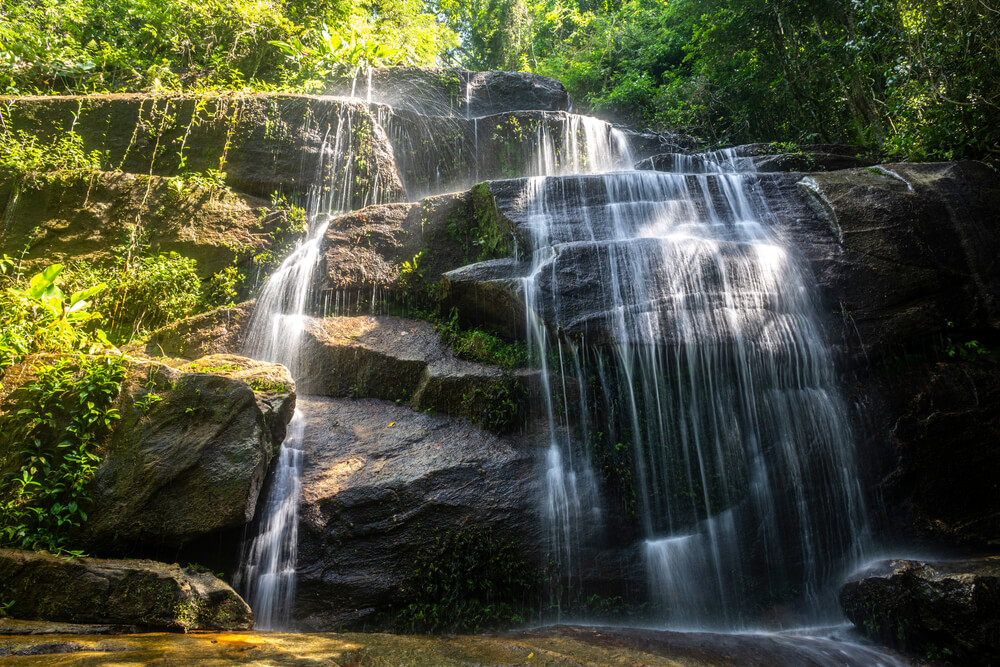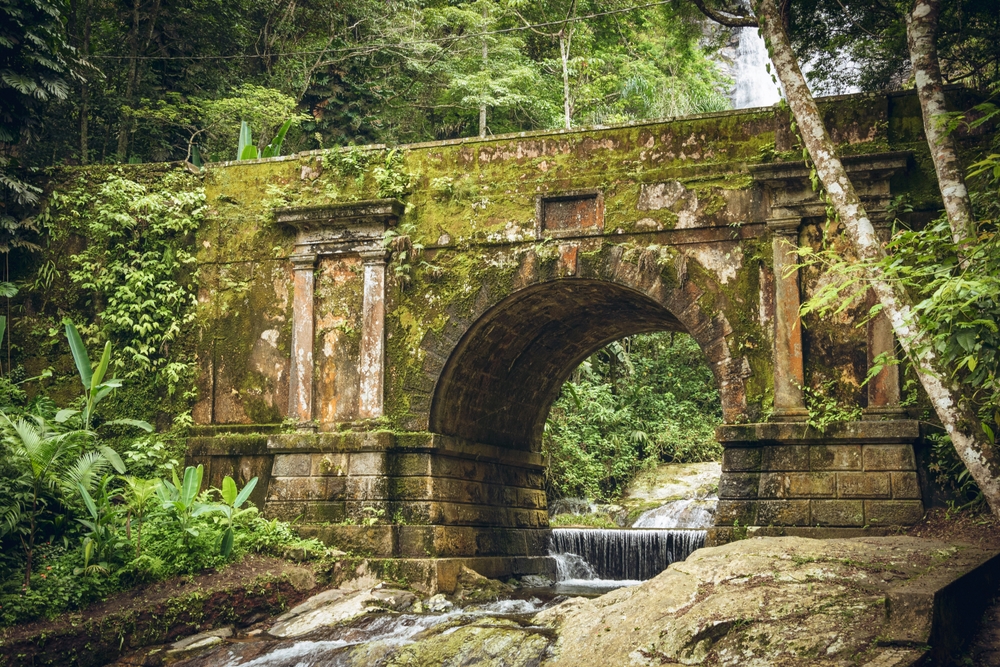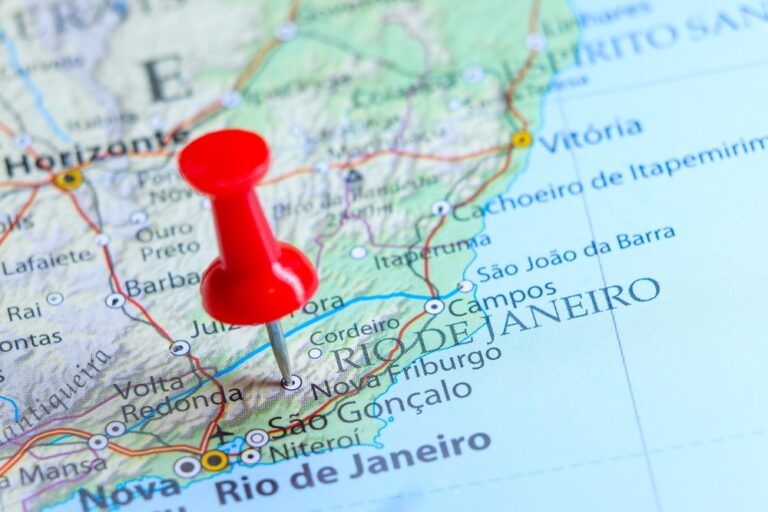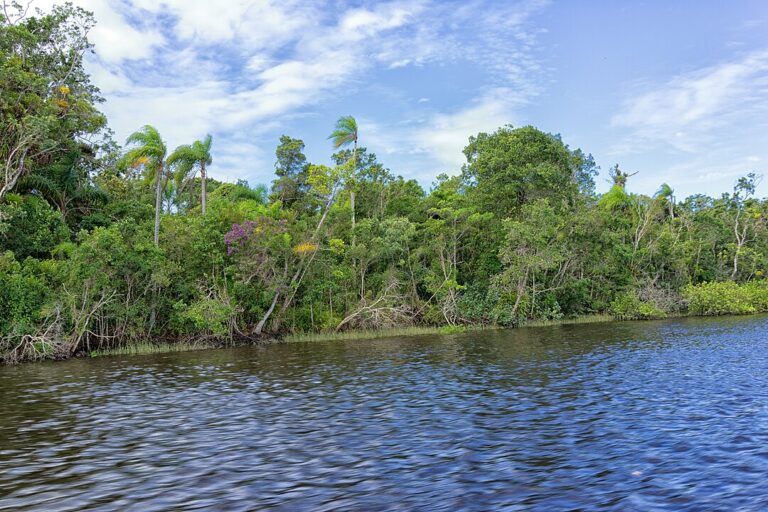Table of Content
ToggleIntroduction
Tijuca National Park, encompassing an area of about 3,200 hectares, stands as a remarkable example of a lush Atlantic rainforest situated within the city limits of Rio de Janeiro, Brazil. This urban forest is recognized as one of the largest of its kind in the world, offering a complex ecological tapestry that intertwines with the city’s vibrant urban landscape. The park boasts a rich history beginning with its establishment in the 1960s, designed to protect and rehabilitate the land from the destructive coffee plantations of the past. Today, its winding trails, waterfalls, and panoramic vistas make it a sanctuary for nature enthusiasts and a vital green lung for Rio de Janeiro.
Within Tijuca National Park, visitors can immerse themselves in the dense rainforest that houses hundreds of plant species, some of which are endemic to the region, and the diverse wildlife including tropical birds, mammals, and reptiles. Iconic landmarks such as the Christ the Redeemer statue and historic sites like the Mayrink Chapel further enhance its cultural importance. Adventure seekers will find numerous recreational activities such as rock climbing and hiking, while the park also serves an important role in environmental education through its guided tours and programs aimed at conservation awareness. Despite its proximity to urban districts, Tijuca remains a natural retreat that provides scenic views and a rare chance to engage with nature amidst the city’s hustle and bustle.
Key Takeaways
- Tijuca National Park is a significant urban rainforest in Rio de Janeiro, known for its trails, biodiversity, and cultural landmarks.
- The park provides various recreational opportunities and is integral in conservation and environmental education efforts.
- Despite its urban setting, Tijuca serves as a natural sanctuary offering visitors panoramic views and access to the Atlantic rainforest ecosystem.
History and Significance of Tijuca National Park
Tijuca National Park is a treasure of Rio de Janeiro, telling a story of significant reforestation and conservation within Brazil’s vibrant environmental narrative.
Rise of the Parque Nacional da Tijuca
Parque Nacional da Tijuca, known in English as Tijuca National Park, was formally established on July 6, 1961, by the Brazilian government, aiming to protect the delicate ecosystems in the midst of Rio de Janeiro. The park encompasses what was once heavily deforested land due to coffee plantations in the 19th century. The creation of the park marked a pivotal moment in Brazil’s commitment to reversing environmental degradation.
Reforestation Efforts and Environmental Impact
In the late 1800s, reforestation efforts began as a monumental task to restore the land. This venture transformed the landscape, recapturing its former biodiversity. The reforestation of Tijuca National Park stands as one of the world’s most successful conservation efforts. Overseen by the Chico Mendes Institute for Biodiversity Conservation, the park serves as a living testament to the power and resilience of nature when supported by determined human intervention.
Exploring the Trails and Hiking Opportunities
Parque Nacional da Tijuca offers a diverse range of trails and hiking opportunities, from leisurely walks to challenging climbs, all set within the lush Atlantic Rainforest.
Popular Hiking Trails
- Circuito das Águas: Ideal for beginners, this trail features waterfalls and serene scenery.
- Trilha do Bico do Papagaio: A moderate hike leading to one of the park’s iconic peaks with panoramic views.
Tijuca National Park is recognized for its extensive trail network catering to all levels of hikers and outdoor enthusiasts.
Pico da Tijuca
- Height: Tijuca Peak, at 1,021 meters, is the second highest point in the park.
- Trail Characteristics: The trail to the summit includes steps carved into the rock and a commanding statue of Christ at the top.
Hiking to Pico da Tijuca provides a rewarding experience with stunning views over Rio de Janeiro and its surroundings.
Adventure Activities
- Rock Climbing: The park’s rock formations offer routes for climbers of various skill levels.
- Hang Gliding: For the thrill-seekers, hang gliding from Pedra Bonita takes adventure to new heights.
The adventure activities in Tijuca National Park are well-organized, with experienced guides and clear trail maps enhancing the visitor experience.
Flora and Fauna of the Tijuca Rainforest
The Tijuca Rainforest boasts a vibrant tapestry of biodiversity, encompassing a plethora of plant species and an impressive variety of wildlife, including numerous birds and mammal species like monkeys, ocelots, and sloths.
Diversity of Plant Species
Tijuca Rainforest is renowned for its rich flora. The diverse vegetation includes over 3,000 species of plants, some of which are unique to the Atlantic Forest region. Among these, towering trees and lush ferns provide the canopy and undergrowth that support the forest’s complex ecosystem. The evergreen and deciduous plants here play an essential role in maintaining the health and balance of the Tijuca environment.
Wildlife Spotting Opportunities
The fauna of Tijuca Rainforest is equally impressive, with opportunities to spot a variety of animal species. Monkeys, such as howler monkeys, often entertain visitors with their calls. The elusive ocelots still roam in this protected area, although they are rarely seen. Bird watchers can enjoy the diversity of avian life, as the forest is home to more than 300 species of birds, ranging from vivid toucans to stealthy raptors. Other mammals like sloths provide a glimpse into the slower pace of life within the dense foliage. Tijuca stands out as a haven for observing and appreciating Brazil’s unique wildlife and flora and fauna.

The Iconic Landmarks within Tijuca National Park
Tijuca National Park, nestled within Rio de Janeiro, Brazil, is dotted with breathtaking landmarks which lure numerous visitors each year wishing to explore its rich history and remarkable scenery.
Christ the Redeemer Statue
The Christ the Redeemer Statue stands majestically atop Mount Corcovado, extending a welcoming embrace over the city. This towering sculpture is not only a symbol of faith but also a representation of Brazilian culture, recognized globally as one of the New Seven Wonders of the World. The base of the statue provides a panoramic view of the park and the city, blending the work of man with the beauty of nature.
Vista Chinesa
Vista Chinesa, an intricately designed Chinese-style pavilion, offers a unique perspective and is one of Tijuca National Park’s most picturesque spots. The lookout is a tribute to the Chinese immigrants that contributed to the region’s tea cultivation and provides enchanting views of Rio, including both the Christ the Redeemer and Sugarloaf Mountain. Here, visitors can indulge in the serenity of the park, poised above the bustling city.
Mayrink Chapel
Surrounded by the dense, verdant forest of Tijuca is the quaint and colorful Mayrink Chapel. With frescoes painted by the famous Brazilian artist Cândido Portinari, the chapel is nestled peacefully within the park’s confines. It not only stands as a spiritual sanctuary but also as a testament to Brazil’s cultural and historical tapestry, blending seamlessly with the natural environment of Tijuca National Park.
Recreational Activities and Adventure Sports
Tijuca National Park offers a range of dynamic recreational activities and adventure sports that cater to thrill-seekers and nature enthusiasts alike. From the thrill of hang gliding to the tranquility of picturesque picnic areas by waterfalls, visitors can immerse themselves in both adrenaline-fueled and restful experiences amidst the park’s rich biodiversity.
Hang Gliding and Rock Climbing
Hang gliding in Tijuca National Park provides a bird’s-eye view of Rio’s breathtaking landscapes, giving adventurers an unmatched sense of freedom. Launching from strategic points within the park, enthusiasts can revel in the aerial panoramas and verdant expanses below. Safety is paramount, with experienced instructors guiding each flight to ensure a memorable experience.
Meanwhile, rock climbing opportunities abound, with a variety of routes that cater to different skill levels. The park’s crags and boulders attract climbers from around the globe. Notable climbing spots include the iconic Pedra da Gáveaand Bico do Papagaio, where climbers can test their abilities while surrounded by the park’s natural beauty. Routes vary in difficulty, offering something for both seasoned climbers and those new to the sport.
Waterfalls and Picnic Areas
The park’s waterfalls, such as Cascatinha de Taunay, the Cascata Gabriela, and the less-explored Cascata Diamantina, serve as idyllic backdrops for relaxation and contemplation. These cascading waters are perfect for visitors to enjoy the cooling mist and the symphony of nature’s sounds. Picnickers can find serene spots near these waterfalls, where they can spread a blanket and enjoy a meal amidst the lush flora.
The picnic areas are well-maintained, ensuring visitors have a comfortable spot to gather with friends and family. Such areas offer a respite from more physically demanding activities, allowing visitors to appreciate the park’s tranquil surroundings and observe the diverse plant and animal life that thrives here. It’s in these peaceful enclaves of Tijuca National Park that guests can truly appreciate the balance between recreational use and the conservation of the park’s invaluable biodiversity.
Natural Attractions and Scenic Views
Tijuca National Park captivates visitors with its panoramic vistas and natural wonders, from the imposing Pedra Bonita to the serene Fairy Lake. Explore the grandeur of towering rock formations, lush gardens, and hidden caverns within Rio de Janeiro’s urban oasis.
Pedra Bonita and São Conrado
Pedra Bonita, a towering granite rock, offers breathtaking views of São Conrado’s beaches and the vast Atlantic Ocean. The hike to its summit is a favorite among enthusiasts, leading to one of the city’s most prized viewpoints. São Conrado, visible from the top, attracts gliders and nature lovers alike.
Waterfalls and Caves
Within the park’s verdant bounds lie the serene Cascatinha Waterfall and a series of intriguing caves. The Cascatinha Waterfall stands out as a natural shower surrounded by rainforest’s tranquility. Visitors can also seek out the caves dotted around the park, offering a cool respite from the tropical heat and a glimpse into geological history.
Emperor’s Table and Excelsior Lookout
Mesa do Imperador (Emperor’s Table), a regal garden picnic spot, used to be the 19th-century retreat for Brazilian royalty. It preserves a historical charm with panoramic views. Not far from there is the Excelsior Lookout, a prime location for those seeking to drink in the natural beauty of Tijuca, with vistas that stretch out over the city and beyond.
Tijuca National Park Accessibility
Tijuca National Park offers visitors an array of accessible entrance points and options for transportation. This section details the various ways to enter the park, the associated fees, and the best times to visit along with transportation advice.
Entrance Points and Fees
Tijuca National Park can be accessed through several entrance points, with Alto da Boa Vista being one of the main gates. Entry to the park is generally free, ensuring visitors can enjoy the natural splendors without a fee. At certain attractions, like the Restaurante Os Esquilos, located within the park’s boundaries, fees may apply for services.
Best Time to Visit and Transportation
The park is open year-round, but the best time to visit Tijuca National Park is during the dry season, from May to August, when the weather is most favorable for hiking and sightseeing. Accessing the park is convenient as it is well-connected by road. Visitors can use a car to arrive at the entrance points such as Rua Jardim Botânico. Public transportation options are also available for those who do not have a private vehicle.

Conservation Efforts and Environmental Education
Tijuca National Park has become a beacon of successful conservation and environmental education within Brazil’s urban forest. These efforts focus on curbing environmental degradation through reforestation and deploying educational initiatives to foster a sustainable relationship between the community and the park.
Role of the Chico Mendes Institute
The Chico Mendes Institute for Biodiversity Conservation (ICMBio) plays a pivotal role in the safeguarding of Tijuca National Park. Tasked with the implementation of conservation strategies, the institute leads reforestation efforts aimed at restoring areas affected by environmental degradation. This active restoration contributes to the maintenance of this urban forest as one of the largest in the world, striving to revert the impacts of deforestation and preserve the habitat for its diverse ecosystems.
Educational Initiatives
Educational initiatives in Tijuca National Park are of paramount importance. Various programs, often in collaboration with the Chico Mendes Institute, emphasize environmental education as a cornerstone of conservation. Activities target local and non-local visitors, providing them with immersive experiences to foster appreciation and understanding of the park’s biodiversity and conservation challenges. Through these educational efforts, individuals are equipped with the knowledge to become active participants in the ongoing efforts to conserve the natural beauty and ecological significance of the park.
Guided Tours and Educational Programs
In Tijuca National Park, visitors can enhance their experience significantly through organized guided tours and educational programs. These offerings are tailored to provide deeper insight into one of the world’s largest urban rainforests, the Floresta da Tijuca.
Benefits of a Guided Tour
Guided tours in Tijuca National Park offer numerous advantages to visitors. First, these tours are led by knowledgeable guides who provide valuable information on the park’s extensive biodiversity and history. They ensure that visitors not only see the beauty of the urban rainforest but also understand its significance.
- Knowledgeable guides with expertise in local flora and fauna.
- Safe navigation through the vast wilderness of the park.
- Insightful stories and facts about the park’s history and significance.
Second, the guided tours can be tailored to the interests of visitors, whether they prefer a leisurely walk through the well-tended paths of the Floresta da Tijuca or a more adventurous hike to the park’s peaks. The guides’ expertise ensures that visitors have an enriching and memorable experience.
Learning Opportunities
Educational programs within Tijuca National Park provide immense learning opportunities about environmental conservation and the importance of urban green spaces. These programs include interactive sessions that engage visitors, especially students, promoting environmental education through firsthand experiences.
- Programs highlight the intricate ecosystem and conservation efforts.
- Activities designed to engage a wide range of age groups.
Educational programs frequently incorporate guided tours, combining learning with the immersive exploration of the rainforest. These tours and programs aim to foster a lasting appreciation and respect for the natural environment among participants.
The educational programs in Tijuca National Park serve as essential tools in educating the public about the critical role that urban rainforests play in maintaining ecological balance. They often address local and global environmental issues, contextualized within the unique setting of the park.
The Urban Context and Impact of Tijuca National Park
Tijuca National Park serves as a testament to the restoration and preservation efforts within an urban landscape, having profound effects on the metropolitan fabric of Rio de Janeiro.
The Park’s Role in Rio de Janeiro’s Urbanization
Tijuca National Park, an expansive urban forest, stands as a green lung within Rio de Janeiro — one of the world’s most densely populated areas. Its rebirth in the late 1800s after deforestation for coffee plantations is a significant example of reforestation success. As an urban oasis, the park has influenced the city’s expansion, providing a natural buffer that shapes urban planning decisions. The presence of this tropical forest in the city uniquely weaves nature into the urban fabric, impacting the social, environmental, and economic aspects of Rio de Janeiro’s growth.
Influence on Barra da Tijuca
Barra da Tijuca, a modern suburb of Rio de Janeiro, has developed in juxtaposition to Tijuca National Park. The urbanization of this area underscores the park’s role not only as a counterpoint to development but also as a driver for high-end residential and commercial growth. The proximity to the national park adds environmental value and shapes the local real estate market. Barra da Tijuca benefits from the park’s ecological services, which include climate moderation, recreation, and serving as a sanctuary of biodiversity contiguous to urban development.
Visitor Facilities and Amenities
Tijuca National Park offers ample facilities and services to enhance the visitor experience, from dining options that cater to various tastes to a well-maintained infrastructure supporting both tourism and conservation efforts. Key attractions such as Corcovado and Christ the Redeemer are well integrated with these offerings ensuring that visitors can comfortably enjoy the natural beauty and iconic sights of the park.
Cafes and Restaurants
- Restaurante Os Esquilos: Nestled within the lush foliage of the park, this quaint restaurant offers traditional Brazilian fare, providing a rustic yet cozy dining experience.
- Parque Lage: Although not a cafe within the park’s bounds, this historic mansion is adjacent to Tijuca and features a lovely cafe that complements a day of sightseeing with light snacks and beverages.
Park Services and Infrastructure
- Paineiras: This area serves as a hub for tourist activity, with facilities including a visitor center, parking spaces, and transport options to Corcovado and Christ the Redeemer.
- Tourism Support: The park’s infrastructure caters to tourism needs, with guided tours, maps, and signage to help visitors navigate and learn about the park.
- Visitor Access: Infrastructure such as well-maintained trails, picnic areas, and lookouts is in place to provide easy access to Tijuca’s attractions, blending convenience with safety.
Frequently Asked Questions
In this section, visitors to Tijuca National Park will find answers to some of the most common queries regarding entrance fees, wildlife, activities, navigation, safety, and tours.
What are the entrance fees for Tijuca National Park?
Tijuca National Park does not charge an entrance fee for general admission, allowing visitors to explore many of its areas free of charge.
What kind of animals can you see in Tijuca National Park?
Visitors to Tijuca National Park can observe a variety of fauna, including species like marmosets, capuchin monkeys, and a diverse range of birds and butterflies.
What are some recommended activities to do in Tijuca National Park?
The park offers hiking trails, refreshing waterfalls, and scenic views from places like the Christ the Redeemer statue and Pedra da Gávea. Visitors often enjoy picnicking, bird watching, and rock climbing.
Where can I find a map of Tijuca National Park?
Maps of Tijuca National Park can be found at the park’s visitor centers or can be downloaded from the official website of Rio de Janeiro’s park service.
How can visitors ensure their safety while in Tijuca National Park?
To stay safe, visitors should stick to marked trails, stay aware of their surroundings, keep hydrated, and follow any safety advice given by park officials.
Are there guided tours available in Tijuca National Park?
Yes, guided tours are available in Tijuca National Park, offering educational insights into the park’s ecology and history, which can be booked through reputable tour operators.












